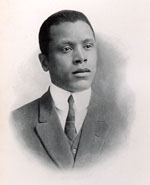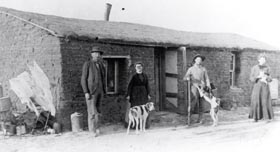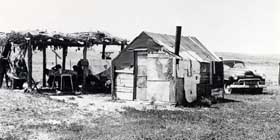|
Lesson 1
Oscar Micheaux and Gertrude Simmons Bonnin
|
| |
Beginning in 1904, people settled the lands west of the Missouri
River. They took land claims on the newly opened reservation
lands. They came from all over the world and from all walks of
life. One man was the son of former slaves.
|
|
|
|
Oscar
Micheaux
|
|
Oscar Micheaux
was born on a farm in the Ohio River Valley in January 1884. His
parents had been slaves before the Civil War. They had thirteen
children to help them work their farm. Oscar did not like farming,
but he liked selling what his family grew.
|

Photo from The Conquest (1913)
|
|
|
|
As a teenager,
Oscar Micheaux left home to work in Chicago. He worked for the
railroad as a
porter. In 1904,
he heard about land openings on the Rosebud Indian Reservation. The
land was in Gregory County, South Dakota. He signed up for the land
lottery (you read about this in Unit 6). His number was not drawn.
Instead, he bought a claim from someone else. It was just south of
the town of Gregory. Micheaux became a successful farmer.
Five years later, he bought more claims in Tripp County. This land
was just west of Winner. Now he owned nearly one thousand acres of
land.
|
|

Photo courtesy of South Dakota State
Historical Society
|
Micheaux
also wrote about life in South Dakota. His first
novel was called The Conquest:
The Story of a Negro Pioneer. Another one was The Homesteader.
In these books, he told the story of living and working on the land
based on his life.
He gave the people and towns new names. Gregory became "Megory."
Winner became "Victor." Then drought came, and crops
failed. Micheaux lost his land. He moved away.
|
|
Micheaux
started a film company in New York City. He made films of his books.
He made The Homesteader into a movie in 1919. He was the
first African American to make a movie in the United States. The
film was also the first to star African Americans. A film crew came
to Tripp County to make it. Micheaux made over thirty-five films.
Some were set in South Dakota. Micheaux has a star on the Hollywood
Walk of Fame. He died in 1951.
|

Photo courtesy of Marty Keenan
|
|
|
|
Gertrude
Simmons Bonnin
|
By 1900, there
were hard times on the reservations. The Dakota, Lakota, and Nakota
(Sioux) people were poor. Their
culture
was under attack. Children were sent away to school. The government
wanted them to be like white people. The Indians wanted their own
way of life.
|
|
|
|
|

Photo from American Indian Stories
(1921)
|
Gertrude
Simmons Bonnin was the daughter of a white man and a Yankton
woman. She saw the needs of the Indian people. She spoke up for
them. She was born on the Yankton Indian Reservation in 1875. Her
Nakota name was Zitkala-Sa ("Red Bird"). She went to local
schools and to boarding schools. Later she taught at Carlisle
Indian School in Pennsylvania. Children went there from all over
the United States. They were taught to be like white people. Bonnin
did not want the old ways to be forgotten. She wrote her first book.
It was about the
traditions of
Indian peoples. It was called Old Indian Legends.
|
Bonnin began to
work on reservations in South Dakota. There she saw the hard lives
of the people. The government had divided the land into farms. The
Dakotas, Lakotas, and Nakotas had no
experience
as farmers. Their land was not good for growing crops. Farming
failed. Indian people sold their land at low prices. The government
gave them less food and supplies. The Indians were very poor.
Gertrude Bonnin
was angry. The United States government was not doing the right
things. It was treating her people badly. It was not doing what it
said in the treaties. The people were sick and
dying. They lived in shacks. The government was not taking good care
of Indian lands. It did not see the value in native ways. Bonnin
spoke about these things in public. In 1916, she moved to
Washington, D.C. There she worked for Indian rights. Later she
started the National Council of American Indians to speak up for
Indians. Her work helped. The government made changes for the better
in the 1930s. Bonnin died in 1938.
|
|

|
|
|
|
| Vocabulary |
|
| culture (n.), ways of doing things that are learned
from one’s society or community
experience (n.), learning gotten by seeing and doing
novel (n.), a long story made up by the writer
|
porter (n.), a person who waits on people riding in a railroad
car
traditions (n.), customs passed down from older to
younger people
|
|
|